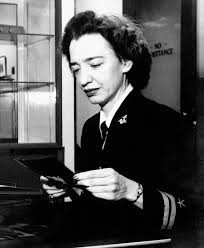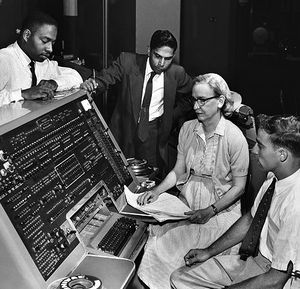Milestone-Proposal:Grace Hopper's Compiler and Programming Language Work, 1952-1959: Difference between revisions
No edit summary |
No edit summary |
||
| Line 56: | Line 56: | ||
|a10=Veronica Joyner, M. Ed., owns the property. Its current use is The Mathematics, Civics, and Science Charter School of Philadelphia, Inc. This is a very successful STEM school for grades 1 to 12 with over 1000 students. | |a10=Veronica Joyner, M. Ed., owns the property. Its current use is The Mathematics, Civics, and Science Charter School of Philadelphia, Inc. This is a very successful STEM school for grades 1 to 12 with over 1000 students. | ||
|a4=[[Image:1946 EniacAtPenn.jpg|thumb]] | |a4=[[Image:1946 EniacAtPenn.jpg|thumb]] | ||
[[image:GMHopper 2.jpg|thumb]] | |||
[[image:Grace Hopper and UNIVAC.jpg|thumb]] | |||
[[image:Grace-hopper-american-computer-scientist-HRP280.jpg|thumb]] | |||
The historical significance of Grace M Hopper's invention of the compiler is the importance of how it affected the modern computer: A compiler is a computer program that translates computer code written in one programming language into another language. The name compiler is primarily used for programs that translate source code from a high-level programming language to a lower-level language to create an executable program. Wikipedia | The historical significance of Grace M Hopper's invention of the compiler is the importance of how it affected the modern computer: A compiler is a computer program that translates computer code written in one programming language into another language. The name compiler is primarily used for programs that translate source code from a high-level programming language to a lower-level language to create an executable program. Wikipedia | ||
Revision as of 15:28, 26 February 2020
To see comments, or add a comment to this discussion, click here.
Docket #:2020-03
This Proposal has been approved, and is now a Milestone
To the proposer’s knowledge, is this achievement subject to litigation? No
Is the achievement you are proposing more than 25 years old? Yes
Is the achievement you are proposing within IEEE’s designated fields as defined by IEEE Bylaw I-104.11, namely: Engineering, Computer Sciences and Information Technology, Physical Sciences, Biological and Medical Sciences, Mathematics, Technical Communications, Education, Management, and Law and Policy. Yes
Did the achievement provide a meaningful benefit for humanity? Yes
Was it of at least regional importance? Yes
Has an IEEE Organizational Unit agreed to pay for the milestone plaque(s)? Yes
Has the IEEE Section(s) in which the plaque(s) will be located agreed to arrange the dedication ceremony? Yes
Has the IEEE Section in which the milestone is located agreed to take responsibility for the plaque after it is dedicated? Yes
Has the owner of the site agreed to have it designated as an IEEE Milestone? Yes
Year or range of years in which the achievement occurred:
1946 through 1958
Title of the proposed milestone:
The Grace M. Hopper Milestone - Grace Hopper created the compiler (translated mathematical notation into machine code) 1950-1952. The COBOL (COmmon Business-Oriented Language) 1952-1957 and implemented standards in early programming languages such as FORTRAN and COBOL in 1970
Plaque citation summarizing the achievement and its significance; if personal name(s) are included, such name(s) must follow the achievement itself in the citation wording: Text absolutely limited by plaque dimensions to 70 words; 60 is preferable for aesthetic reasons.
IEEE MILESTONE IN COMPUTER ENGINEERING & COMPUTER SCIENCE The invention of the compiler for computers, COBOL Language and Standards, in 1952
Grace Murray Hopper was one of the first programmers of the Harvard Mark I computer. She was a pioneer of computer programming and invented and coined the term compiler. She popularized the idea of machine-independent programming languages, which led to the development of COBOL, an early high-level programming language still in use today. Grace developed the implementation of standards for testing computer systems and components, most significantly for early programming languages such as FORTRAN and COBOL. She coined the expression computer “Bug”. She retired from the Navy as Rear Admiral. Grace worked on many teams and programs. She was often referred to as “Amazing Grace”.
200-250 word abstract describing the significance of the technical achievement being proposed, the person(s) involved, historical context, humanitarian and social impact, as well as any possible controversies the advocate might need to review.
IEEE technical societies and technical councils within whose fields of interest the Milestone proposal resides.
In what IEEE section(s) does it reside?
IEEE Philadelphia Section
IEEE Organizational Unit(s) which have agreed to sponsor the Milestone:
IEEE Organizational Unit(s) paying for milestone plaque(s):
Unit: IEEE Philadelphia Section
Senior Officer Name: Emilio M. Salgueiro, Chair
Unit: IEEE Membership Committee
Senior Officer Name: Kathleen M. McDevitt, Chair
IEEE Organizational Unit(s) arranging the dedication ceremony:
Unit: IEEE Philadelphia Section
Senior Officer Name: Emilio M. Salgueiro, Chair
Unit: IEEE Membership Committee
Senior Officer Name: Kathleen M. McDevitt, Chair
Unit: IEEE Women In Engineering Affinity Group, Philadelphia
Senior Officer Name: Maria Tabbut
IEEE section(s) monitoring the plaque(s):
IEEE Section: IEEE Philadelphia Section
IEEE Section Chair name: Emilio M. Salgueiro, Chair
Milestone proposer(s):
Proposer name: Kathleen M McDevitt (Kate)
Proposer email: Proposer's email masked to public
Please note: your email address and contact information will be masked on the website for privacy reasons. Only IEEE History Center Staff will be able to view the email address.
Street address(es) and GPS coordinates in decimal form of the intended milestone plaque site(s):
Describe briefly the intended site(s) of the milestone plaque(s). The intended site(s) must have a direct connection with the achievement (e.g. where developed, invented, tested, demonstrated, installed, or operated, etc.). A museum where a device or example of the technology is displayed, or the university where the inventor studied, are not, in themselves, sufficient connection for a milestone plaque.
Please give the details of the mounting, i.e. on the outside of the building, in the ground floor entrance hall, on a plinth on the grounds, etc. If visitors to the plaque site will need to go through security, or make an appointment, please give the contact information visitors will need. The Mathematisc, Civices, and Sciences Charter School of Philadelphia, Inc. is a very successful STEM school for grades 1 to 12 grade with over 1000 students. It is own and the property it sits on by Veronica Joyner, M. Ed.
Are the original buildings extant?
yes
Details of the plaque mounting:
The plaque will be placed In concrete in the sidewalk. This will be a Walk of Fame for Women of Science similar to Philadelphia's Avenue of The Arts and The Hollywood Walk of Fame. It is for the hidden figures of Science.
How is the site protected/secured, and in what ways is it accessible to the public?
It is protected by an insurance policy. Since it is in the sidewalk it is very visible to the public and is available for twenty-four hours a day and whenever anyone walks down the street. It will be extremely hard to pry the plaque out of the sidewalk. visible to the public
Who is the present owner of the site(s)?
Veronica Joyner, M. Ed., owns the property. Its current use is The Mathematics, Civics, and Science Charter School of Philadelphia, Inc. This is a very successful STEM school for grades 1 to 12 with over 1000 students.
What is the historical significance of the work (its technological, scientific, or social importance)? If personal names are included in citation, include detailed support at the end of this section preceded by "Justification for Inclusion of Name(s)". (see section 6 of Milestone Guidelines)
The historical significance of Grace M Hopper's invention of the compiler is the importance of how it affected the modern computer: A compiler is a computer program that translates computer code written in one programming language into another language. The name compiler is primarily used for programs that translate source code from a high-level programming language to a lower-level language to create an executable program. Wikipedia
What obstacles (technical, political, geographic) needed to be overcome?
Grace M. Hopper's biggest obstacle was convincing her superiors and co-workers that it would work technically. The politics of convincing an all-male audience took three years for acceptance.
What features set this work apart from similar achievements?
The features that set this work apart from similar achievements is that is was the missing link in the program. She created an executable program that translated source code.
Why was the achievement successful and impactful?
Supporting texts and citations to establish the dates, location, and importance of the achievement: Minimum of five (5), but as many as needed to support the milestone, such as patents, contemporary newspaper articles, journal articles, or chapters in scholarly books. 'Scholarly' is defined as peer-reviewed, with references, and published. You must supply the texts or excerpts themselves, not just the references. At least one of the references must be from a scholarly book or journal article. All supporting materials must be in English, or accompanied by an English translation.
Supporting materials (supported formats: GIF, JPEG, PNG, PDF, DOC): All supporting materials must be in English, or if not in English, accompanied by an English translation. You must supply the texts or excerpts themselves, not just the references. For documents that are copyright-encumbered, or which you do not have rights to post, email the documents themselves to ieee-history@ieee.org. Please see the Milestone Program Guidelines for more information.
Please email a jpeg or PDF a letter in English, or with English translation, from the site owner(s) giving permission to place IEEE milestone plaque on the property, and a letter (or forwarded email) from the appropriate Section Chair supporting the Milestone application to ieee-history@ieee.org with the subject line "Attention: Milestone Administrator." Note that there are multiple texts of the letter depending on whether an IEEE organizational unit other than the section will be paying for the plaque(s).
Please recommend reviewers by emailing their names and email addresses to ieee-history@ieee.org. Please include the docket number and brief title of your proposal in the subject line of all emails.



